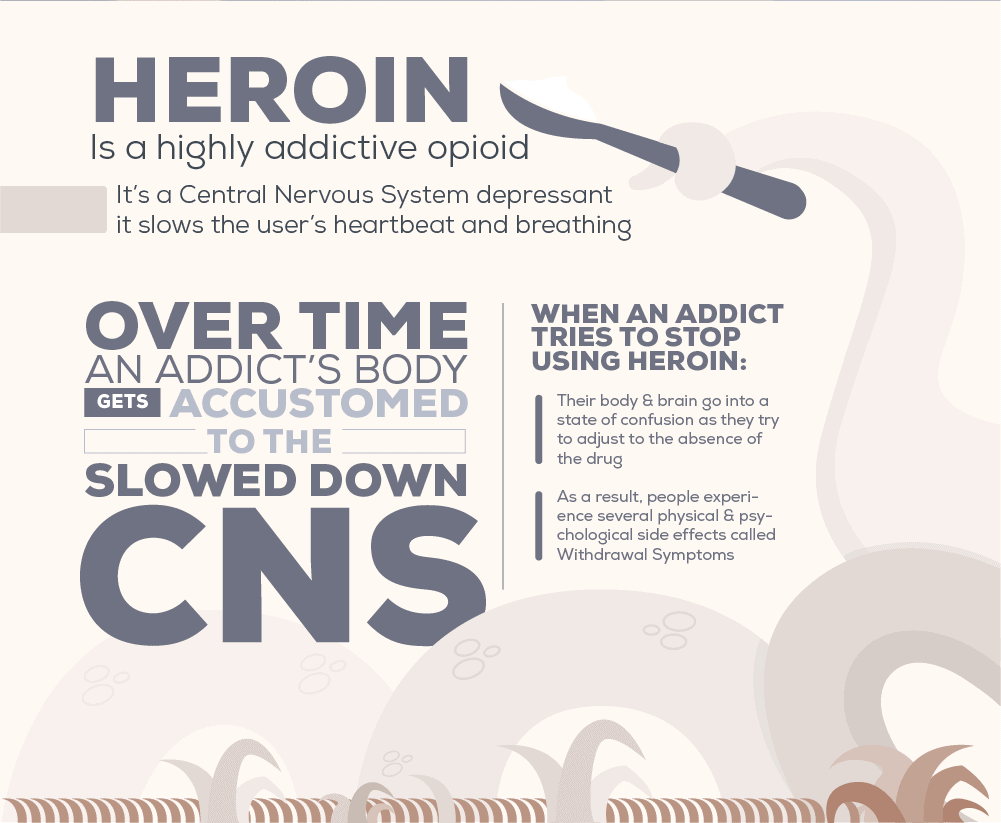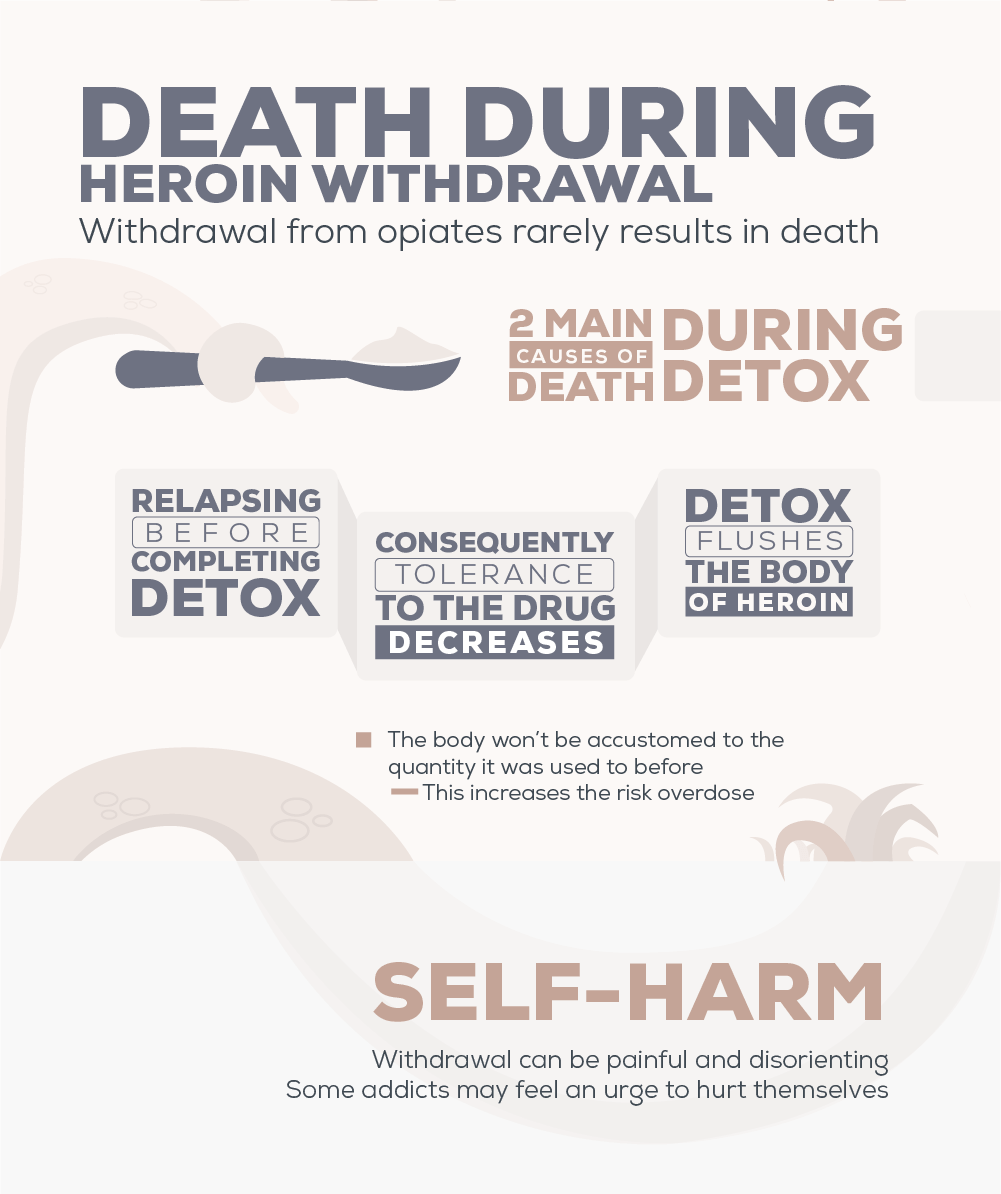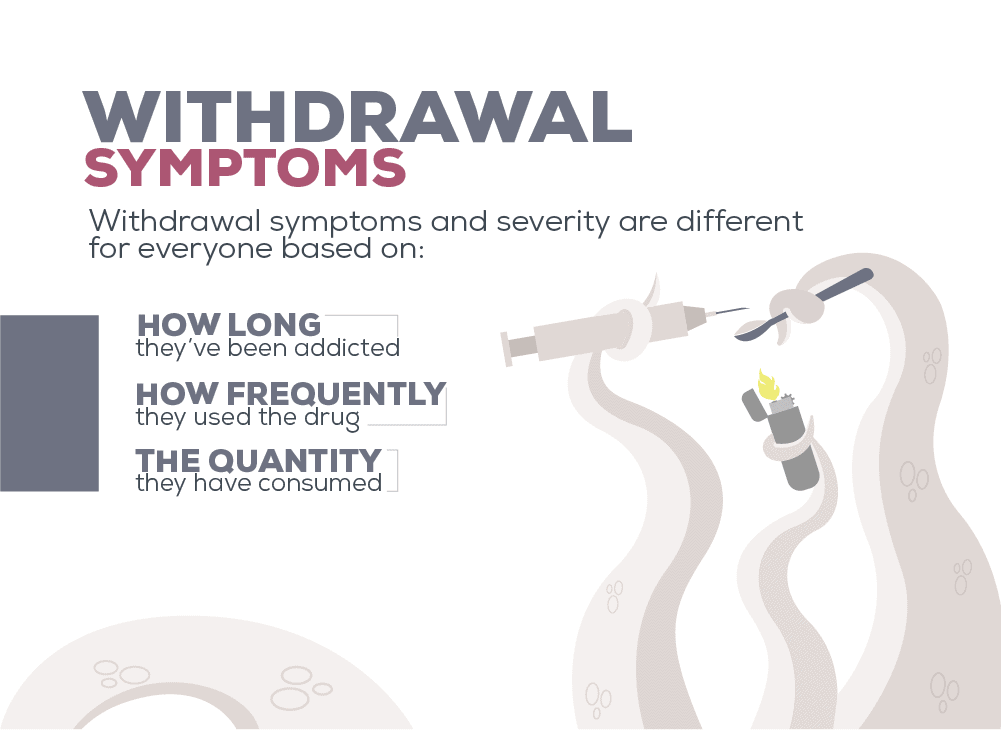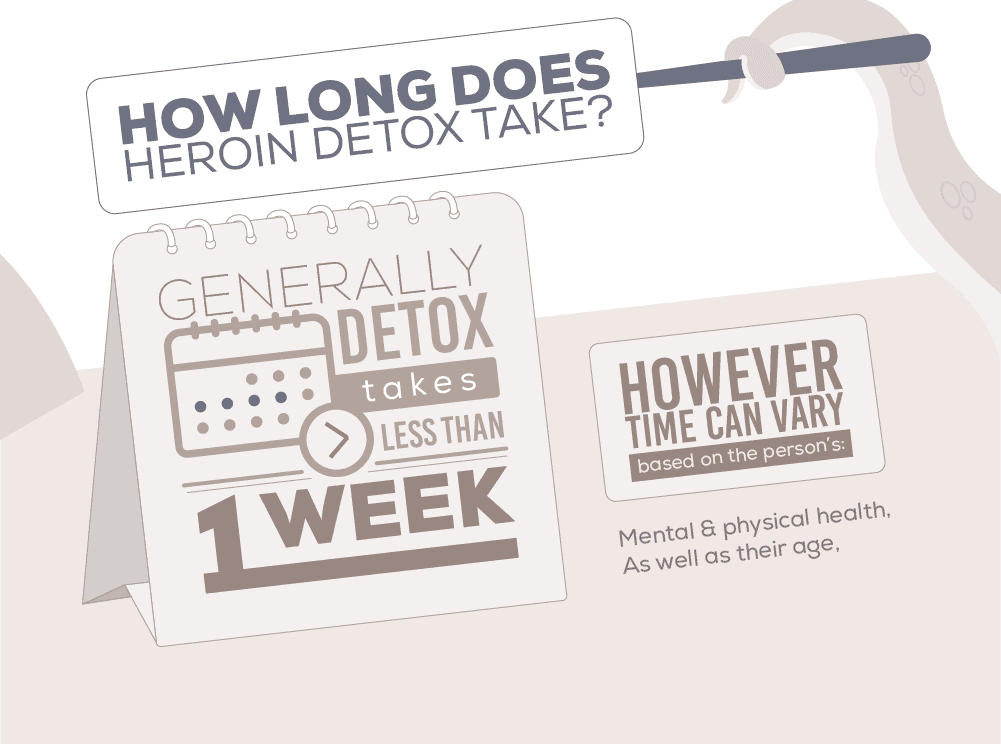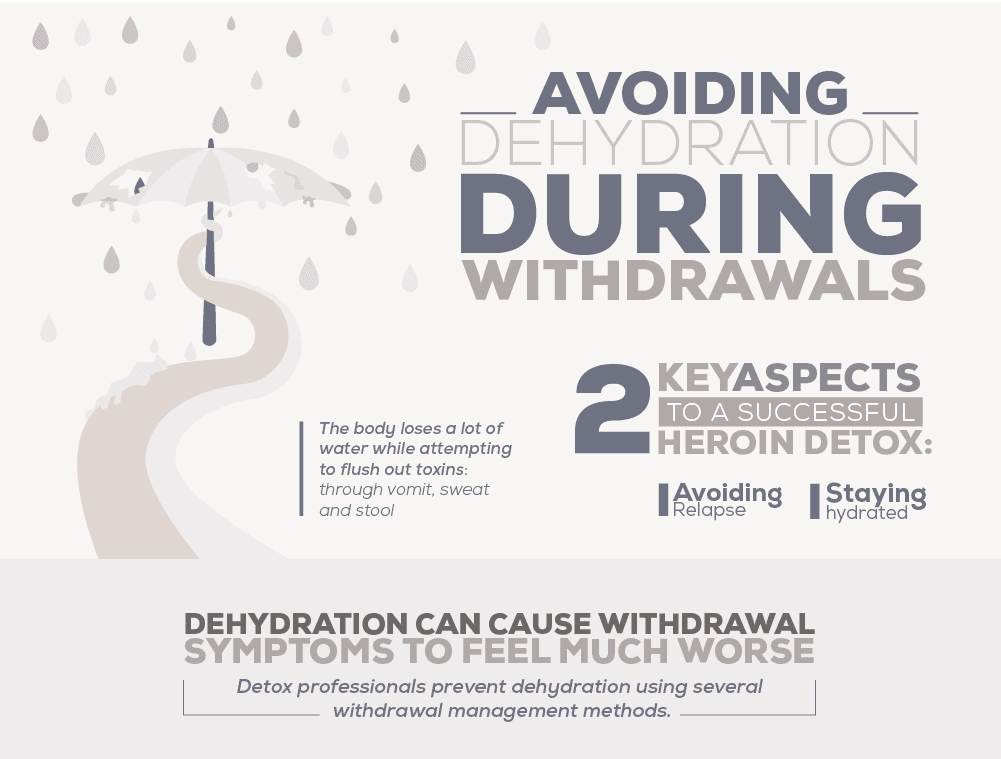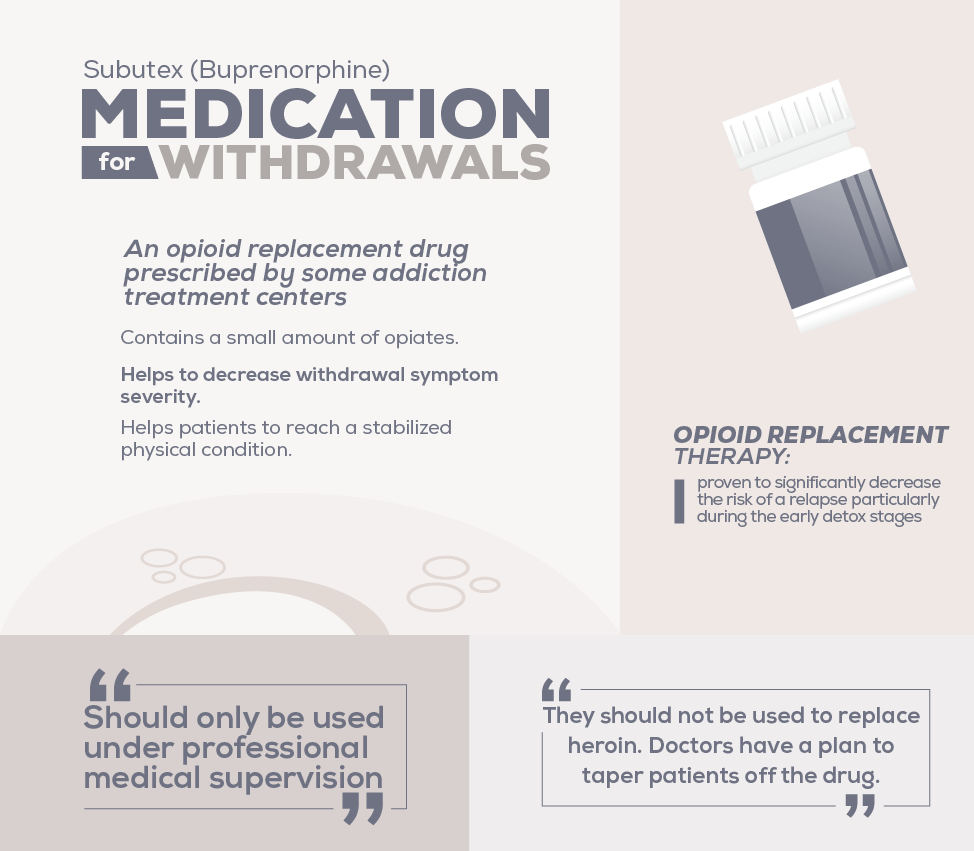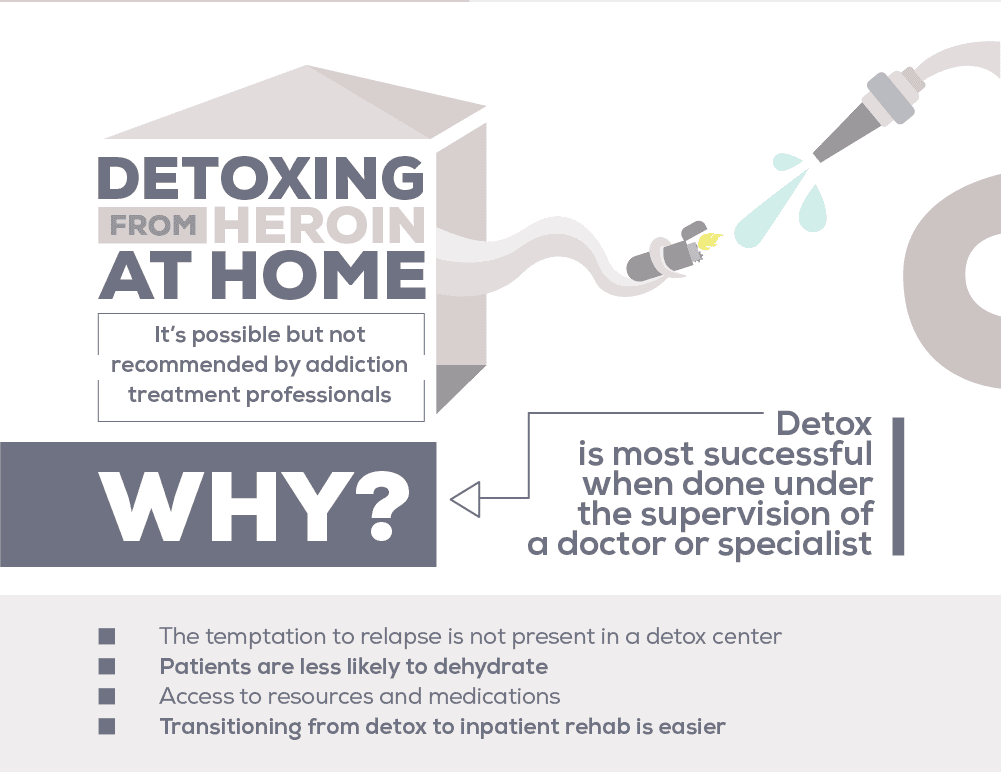Heroin withdrawal can be a scary process. Maybe you’ve heard stories from opiate addicts that have gone through it. People who detox from opioids often experience intense nausea, stomach cramping, severe anxiety and insomnia among other symptoms. It’s no wonder, then, that the prospect of withdrawing can be quite intimidating. The mere thought of going through withdrawals is enough to deter some heroin addicts from quitting. However, once someone is able to overcome the symptoms of heroin withdrawal, they’ll have jumped over one of the biggest hurdles in the recovery process. Making it through detox without relapsing means that the individual has taken one of the biggest steps toward getting clean. After the detox process, they will have successfully cleansed their body of the toxins associated with this illicit drug. If you’re struggling with heroin addiction and thinking about withdrawal, this article will outline some important information for you. In particular, you’ll learn about withdrawal and detox.
“We treat heroin addiction and accept many health insurance plans. Take a look at our Outpatient Program.”
First Things First—What is Heroin Withdrawal?
Heroin is an opioid. It produces a chemical in the body that sticks to our “opioid receptors”. These are small receptors in our brain that enable us to feel happy. That is why the drug causes users to feel euphoric for a certain amount of time after drug addicts have taken it. When someone uses opiates repeatedly, their brain becomes accustomed to the chemical and starts to depend on it. It will rely on the heroin to artificially boost the amount of ‘happy chemicals’ in the brain. Heroin also causes the user’s central nervous system to slow down. When opioids stick to the brain’s receptors, the brain sends a signal to the heart, circulatory system, lungs and other parts of the body, telling them that they don’t need to work so hard. This is one reason why someone who uses opiates feels relaxed with the drug in their system. The opioid depresses breathing and causes a whole array of unwanted side effects. An addict’s body will become accustomed to a slowed-down nervous system, as well, if they use the drug for a long enough period of time. All of the symptoms felt during withdrawal—the anxiety, the nausea, the rapid heart rate, etc.—are a result of the body trying to cope with the absence of heroin. The brain may go haywire as it attempts to re-calibrate itself without opioids. The user’s body might hurt as their nervous system starts to operate at the correct speed. The nausea and vomiting that we associate with heroin withdrawal occur as the body attempts to flush the remaining chemicals out. It’s the body’s way of adjusting to the change.
Here’s an Analogy
Heroin causes neurochemical levels in the brain to increase anywhere from 2 to 10 times the initial amount. Since heroin causes an influx in neurotransmitters like dopamine and serotonin, the brain starts to make less and less of it. Think of it like this. If a bakery finds itself constantly being flooded and stocked with a certain product, it’ll start to make less of a certain product. It’ll lower its production to accommodate for the influx, not knowing that it’s actually from an external source. Someone actually comes into the bakery and stock it with the product. The product is still being consumed at the same rate. If the external source all of a sudden stops stocking the shelves, this doesn’t mean that the demand has been lowered. But, the bakery won’t have ordered enough of it to cater to the demands of its customers. As a result, it’ll start to get a lot of complaints. These complaints are like withdrawal symptoms.
Can You Die From Heroin Detox?
Heroin withdrawals themselves will not kill you. Unlike detoxing from benzos or alcohol, quitting heroin rarely results in death. If done properly and with supervision, the detox process can go safely and smoothly. The deaths that do occur happen for reasons that aren’t related to heroin withdrawals themselves. If an individual relapses before (or shortly after) completing detox, they can face fatal consequences. Once an addict flushes enough of the drug out of their system, their tolerance will decrease and they won’t be able to use the quantity of the drug that they may be accustomed to. If they start to use heroin again, the dosage that they take can overwhelm their system and result in an overdose. Other people die during heroin withdrawal due to self-harm. Because the process can be painful and disorienting, some addicts develop the need to hurt themselves during detox. Heroin detox can lead to suicidal thoughts and depression. It is for both of these reasons that detoxing from heroin in a rehab facility or addiction treatment center is highly recommended. Not only will the staff provide support and help to prevent a relapse, but medical professionals will also be at the facility to make sure you’re safe. They will also work to make sure you stay hydrated which, as you’ll learn in this article, is one of the keys to making opioid withdrawal as easy as possible. There are also no items there that can cause self-harm.
Common Symptoms and Signs
The symptoms of heroin withdrawal are different for everyone. The severity of side effects will depend on how long they’ve been addicted, how often they’ve used the drug and how much of it they’ve consumed. Symptoms come in two forms: physical and psychological. Physical side effects will usually only occur during the heroin withdrawal process itself. Once the addict has finished flushing the drug out of their system, it is unlikely that they will continue to experience these effects. 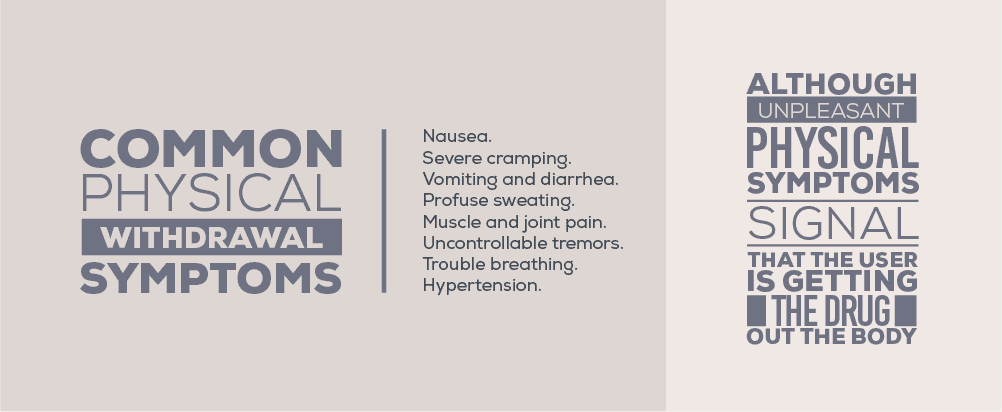 Physical Withdrawal Symptoms The physical withdrawal symptoms are the easiest to deal with. They’ll usually start to subside during the detox process, and will completely disappear by the end of the heroin addiction treatment. Some common physical withdrawal symptoms include:
Physical Withdrawal Symptoms The physical withdrawal symptoms are the easiest to deal with. They’ll usually start to subside during the detox process, and will completely disappear by the end of the heroin addiction treatment. Some common physical withdrawal symptoms include:
- Nausea
- Severe cramping
- Vomiting and diarrhea
- Profuse sweating
- Chills and goosebumps
- Muscle and joint pain
- Uncontrollable tremors
- Trouble breathing
- Hypertension (This may be a long-lasting side effect if caused by the heroin use itself. Those who are prone to heart problems and take opiates are always at risk of developing hypertension).
As it was pointed out above, each of these side effects is a sign that the body is expelling opioids from its system. While they may not be pleasant, the physical symptoms of heroin withdrawal signal that the user is getting the drug out of their body and therefore making huge strides toward a healthy recovery. Although the physical withdrawal symptoms can be difficult to handle in the beginning, they become easier and easier to manage with time. The peak of the intensity is usually two to three days after the last dose. Medical detox with medications like Suboxone can help ease these withdrawal symptoms by rebalancing the neurochemical levels in the brain. Keep in mind that the medications used in medical detox can be addictive as well. These drugs tend to be weaker opioids. They’re part of a treatment known as Opiate Replacement Therapy (ORT). 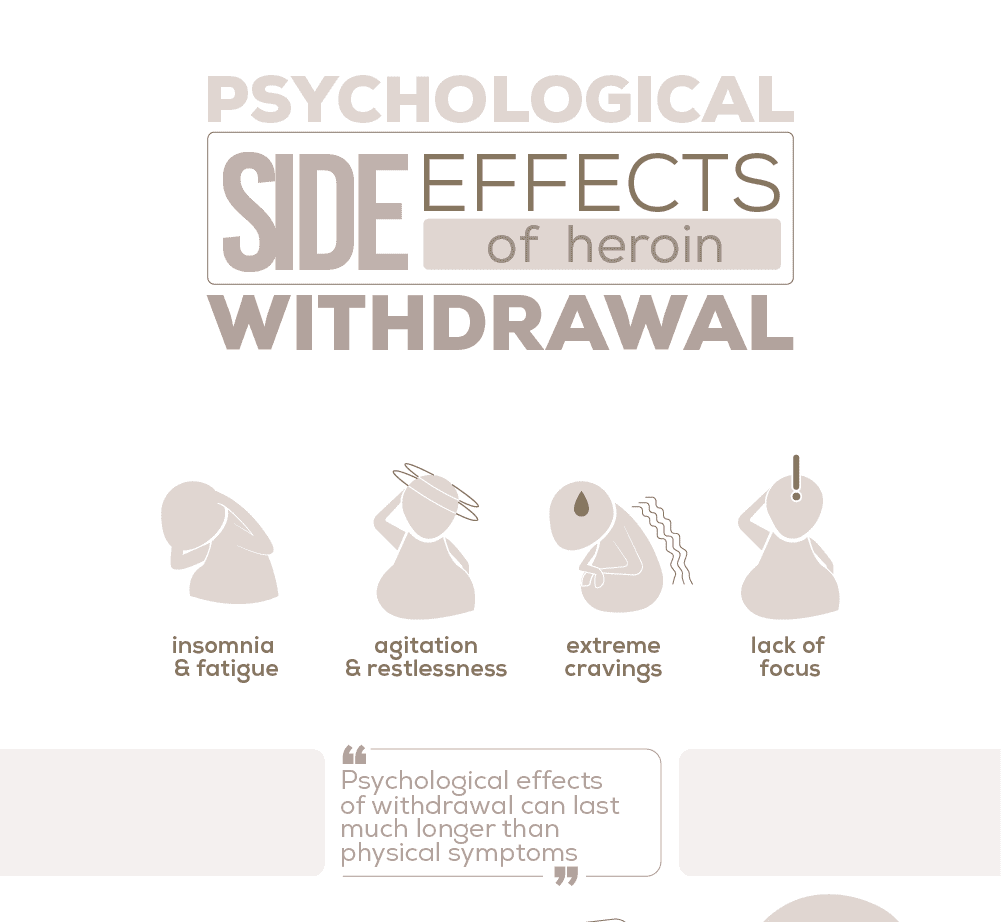 Psychological Withdrawal Symptoms Psychological withdrawal symptoms are much more difficult to deal with. Unlike with physical heroin withdrawal symptoms, there’s no end date. It’s possible for a heroin addict to experience psychological withdrawal symptoms randomly. These symptoms can even pop up after the detox process. Some of the psychological side effects of heroin withdrawal include:
Psychological Withdrawal Symptoms Psychological withdrawal symptoms are much more difficult to deal with. Unlike with physical heroin withdrawal symptoms, there’s no end date. It’s possible for a heroin addict to experience psychological withdrawal symptoms randomly. These symptoms can even pop up after the detox process. Some of the psychological side effects of heroin withdrawal include:
- Extreme cravings
- Agitation and restlessness
- Insomnia
- Depression
- Fatigue
- Anxiety
- Lack of focus
- Inability to feel pleasure
The psychological aspects of heroin withdrawal can last much longer than physical symptoms. This is due, in part, to the fact that heroin use itself causes psychological side effects. While the addict will probably feel cravings during detox, for example, it is likely that they will experience cravings from time to time even after they’re clean. This is normal. To prevent relapses, it’s vital that the recovering addict learns how to manage these symptoms through behavioral therapies like Cognitive Behavioral Therapy (CBT). Similarly, the anxiety and depression that result from heroin withdrawal can be side effects of the addiction itself. While these symptoms may diminish as the user works through recovery, it is normal for addicts to cope with these emotions for years after they become sober. Some recovering addicts may continue to feel depressed as the neurochemical levels in their brain attempt to return to normal levels. This process can take quite some time.
How Long Does Heroin Detox Take?
The withdrawal timeline will vary depending on the addict. Mental and physical health, as well as the addict’s age, will have an effect on the length of the detox process. Generally, however, withdrawing from opiates doesn’t take much longer than a week.  A typical timeline looks like this: Days 1-2: The addict can start to experience withdrawal symptoms within twelve hours of their last dose. Those who use the drug chronically may start to feel side effects in as few as six hours. At first, the addict will feel irritated and anxious. They will probably consider relapsing to ease their anxiety. Additionally, they will start to experience nausea, diarrhea and other feverish symptoms. It will be uncomfortable, but those who are able to make it through this time period without relapsing will be in a much better position to handle the rest of the detox process. Days 3-5: The severity of the physical symptoms will peak and then decrease in intensity. The addict might still feel nauseous and experience cramps, but it is likely that they won’t feel as much pain as they did earlier in their withdrawals. It is likely that the user will still experience cravings, anxiety, and restlessness due to the lack of the drug in their system. They will probably, however, be able to think much more clearly than they had been able to for the previous few days. Days 6-7+: Physical symptoms will probably have passed entirely at this point. Anxiety may fluctuate and the user might start to feel depressed. If the addict is withdrawing from heroin in a detox facility, they will probably be transferred to an inpatient rehab program or a residential. Those who detox at home on their own should consider seeking further rehabilitation support in the form of drug counseling or group therapy at this point.
A typical timeline looks like this: Days 1-2: The addict can start to experience withdrawal symptoms within twelve hours of their last dose. Those who use the drug chronically may start to feel side effects in as few as six hours. At first, the addict will feel irritated and anxious. They will probably consider relapsing to ease their anxiety. Additionally, they will start to experience nausea, diarrhea and other feverish symptoms. It will be uncomfortable, but those who are able to make it through this time period without relapsing will be in a much better position to handle the rest of the detox process. Days 3-5: The severity of the physical symptoms will peak and then decrease in intensity. The addict might still feel nauseous and experience cramps, but it is likely that they won’t feel as much pain as they did earlier in their withdrawals. It is likely that the user will still experience cravings, anxiety, and restlessness due to the lack of the drug in their system. They will probably, however, be able to think much more clearly than they had been able to for the previous few days. Days 6-7+: Physical symptoms will probably have passed entirely at this point. Anxiety may fluctuate and the user might start to feel depressed. If the addict is withdrawing from heroin in a detox facility, they will probably be transferred to an inpatient rehab program or a residential. Those who detox at home on their own should consider seeking further rehabilitation support in the form of drug counseling or group therapy at this point.
“Get the help you need today. We offer outpatient assistance, so you can maintain your work, family, and life commitments while getting the help you deserve!”
Does Heroin Withdrawal Cause Seizures?
Unlike detoxing from alcohol and benzos, heroin detox does not usually cause seizures. There are rare cases in which, due to dehydration, the user’s body becomes chemically imbalanced and mineral deficient, leading them to experience a seizure. While the research is not exactly clear as to why this occurs in some people but not others, it is possible. Addicts can decrease the risk of a seizure by remaining hydrated throughout the entire process. They can also make sure that they stay well nourished by eating small number of nutrient-rich foods. High-fiber foods like whole grain bread or green vegetables will provide the addict with some form of nourishment and speed up the metabolism as well. This will ensure that the digestive system keeps functioning properly and that the risk of a seizure isn’t present.
Avoiding Dehydration During Withdrawals
There are two key aspects to a successful heroin detox: avoiding relapse and staying hydrated. Hydration is important during the initial stages of recovery, as the addict’s body will lose a lot of water very quickly. As the body attempts to flush out the leftover byproducts of opiate use through vomit, sweat, and stool, the water in the user’s body will go with it. Dehydration can cause withdrawal symptoms to feel much worse. Without water to expel, the body will take much longer to flush the drug out of its system. Detox professionals prevent dehydration using a number of withdrawal management methods. They will most likely provide the addict with a cup of ice water to sip periodically throughout the process. In extreme cases, it may be necessary to hydrate the addict using intravenous methods.
The Prevalence of Suicide During Detox
Suicide is prevalent among heroin users. Anywhere from 3% to 35% of heroin users will end up committing suicide. These numbers are 14 times higher than other drug users. Suicide is more prevalent among these drug addicts than in the general population. It’s considered to be a major clinical problem. It’s important for those who will be withdrawing from heroin to be aware of this fact. They need to act accordingly to keep themselves safe. It’s not necessarily the heroin that causes users to commit suicide. Rather, it’s the pain from the withdrawals and the neurochemical imbalance. These drug abusers often suffer from co-occurring disorders like depression. When the withdrawals kick in, many drug abusers claim that they want to die. The symptoms are not only intense, but they are incredibly painful. Many drug users feel as if the only way out is to either relapse or to commit suicide or hurt themselves. Those with a heroin addiction are more likely to struggle with suicidal thoughts. They exhibit many of the risk factors that lead to suicide. Some of the most common risk factors include social isolation, family dysfunction and psychopathology. Heroin users tend to have wider exposure to these factors. There are many ways to combat this issue. In particular, many experts urge these drug abusers to seek professional treatment from a drug rehab center. An inpatient treatment program provides a safe and stable environment for those withdrawing from heroin. The treatment facilities are safe and do not carry any instruments that can cause harm. Patients are also under 24-hour medical supervision. If they ever feel suicidal, they can get help right away from a counselor, from other patients or from the addiction specialists.
Tips for Preventing Suicide From Heroin Withdrawals
Since suicide is so prevalent among heroin users, it’s vital that they get the help that they need. Drug abusers who are going through the withdrawal process need to be prepared. They should take preventative action ahead of time to keep themselves safe. There are plenty of things that a recovering addict can do. Some tips and tricks on how to prevent suicide from heroin withdrawals include:
- Detoxing at a residential treatment center or a qualified drug detox center. These centers are set up to provide a safe and calm environment for dealing with withdrawals.
- Getting support and therapy. Talking to a qualified counselor can do wonders. It’s important to learn coping strategies for dealing with the pain. Many addiction counselors recommend using relaxation techniques.
- Reminding yourself that the pain of dope sickness will eventually end. Although the pain feels unbearable at the moment, it will end. You can get sober, and it will all be worth it at the end.
- Removing any dangerous instruments from the home. This includes wires, cords, metallic objects that can into wall sockets and knives.
- Relying on family and friends for support. If you’re attempting to detox at home, let loved ones know. Have them call or check-up on you regularly to see how you’re doing.
With motivation, perseverance and determination, it’s possible to kick a heroin habit. The pain from dope sickness will eventually subside. The morbid thoughts will also go away as well. Soon, your mind will clear and you’ll feel like a different person. You’ll feel healthier and more motivated to tackle on some of life’s hardest obstacles.
Is There Any Medication for Withdrawals?
There are a variety of drug treatments designed to make the heroin detox process easier. Some addiction treatment centers prescribe Subutex (buprenorphine), for example, which supplies the addict with a small amount of opiates to help fight off withdrawal symptoms. Some opioid replacement drugs are shown to greatly decrease the risk of a relapse, particularly during the earliest stages of detoxification. Heroin withdrawal treatment drugs should only be used under the supervision of a medical professional. Medications like Subutex can present a number of risks and therefore should not be taken without a doctor’s instruction. The intention of these drugs is to act as an aid to the addict during the detox process, not to replace heroin entirely. A doctor, therefore, will make sure that the addict is tapering off of their replacement drug at a healthy rate and ensure that they are safe in doing so.
Popular Types of Medications Used in Opiate Replacement Therapy (ORT)
Plenty of different drugs are used for heroin detox. This type of medical detox is also known as Opiate Replacement Therapy (ORT). These compounds are essentially weaker opioids. They act on the same opioid receptors. These compounds will bind to the same receptors and basically set off the same chain of actions. The only difference is that they tend to be weaker. This makes it easier for the drug abusers to wean off of later. We’ve already mentioned Subutex above, but there are a lot of other options available. The medication that’s best for each patient will vary depending on his or her needs and preferences. Some patients will respond better to certain medications than others. No one really knows why. This is the reason behind why some heroin users will try more than one medication to get over heroin abuse. Some of the best medications used in ORT in 2017 include:
- Methadone, which is a full opioid agonist. Methadone is quite strong. As a result, it’s possible to develop a secondary addiction to this drug. Patients must follow a strict schedule to prevent this from happening.
- Buprenorphine, which is a partial opioid agonist. The thing that makes buprenorphine special is that it has a “ceiling effect”. Once a certain dose of this medication has been taken, taking more than that dose will not result in the patient getting even higher.
- Naltrexone, also known as Vivitrol. Naltrexone is special in the sense that it is an opioid antagonist. It prevents opioid users from feeling the effects of the drug even if they take it. This drug is a not a narcotic. It also isn’t addictive at all.
Look for an inpatient rehab center that can offer all types of medications. Ashwood Recovery offers Vivitrol services for those who struggle with alcoholism or opiate addiction.
Agonists vs. Antagonists
So, what’s the difference between the different medications? Simple. They have different actions on opioid receptors. Some are agonists and some are antagonists. Agonists are chemicals that stimulate the receptors. They have a similar chain of action as strong opioids, like heroin. They will cause the patient to experience euphoric sensations. Full opioid agonists do not have a maximum threshold. The more that a person takes, the higher they get. Partial opioid agonists have a “ceiling effect”, so it’s harder to get high on these drugs. Antagonists, on the other hand, function in the opposite manner. Instead of stimulating opioid receptors, these compounds block them. They have a high affinity for the opioid receptors. Once the compound attach and bind to the receptors, they stay there. This prevents opioid molecules from being able to attach or bind to the receptors. As a result, even if the drug users were to take opioids, they wouldn’t feel the effects at all.
Other Drugs Used to Treat Heroin Withdrawal Symptoms
There are other drugs used to treat withdrawal symptoms of heroin abuse as well. These drugs have not specifically been approved by the Food and Drug Administration for treating an opioid addiction. Whether they are prescribed or not will depend on the treatment consultant. Medical professionals monitor each patient to see what withdrawal symptoms they experience. They also make note of the intensity of the symptoms. If a certain symptom is becoming too overwhelming, it may be treated with other medications. For example, the health providers may prescribe sleeping pills to a person who is having difficulties sleeping at night. This will allow them to have a better quality sleep, which can also help them to speed up their recovery.
Can I Detox from Heroin at Home?
While it is possible to go through heroin withdrawals at home, most addiction treatment professionals don’t recommend it. The detox process is most successful when the addict goes through it under the supervision of a doctor or specialist. Someone who detoxes in a professional facility is far less likely to dehydrate. They will also have access to resources and medications that will make the process go much smoother. Furthermore, the temptation to relapse is not present in a detox center. When the patient is on campus at the treatment facility, they won’t have access to opiates that can feed their craving. Withdrawals can be intense and those who try to quit on their own are far more likely to seek out a dose once the symptoms become too harsh. Those who attempt to detox at home need to have a safe and stable home environment. When the brain sees familiar stimuli, it is far more likely to start to experience intense cravings. The most valuable aspect of detoxing in a rehab center is that the addicts will be only a few steps away from inpatient rehabilitation. This makes the transition from detox to rehab as easy as possible. Once they enter the rehab program, they’ll receive counseling and support from addiction professionals as well as other addicts. While it may be possible to detox from home, there is no real treatment at home.
Tips and Tricks on How to Detox at Home
If residential placement or an inpatient program is not possible, detoxing at home may be your only option. While professionals do not recommend it, detoxing at home is possible. In these cases, preparation is vital for a successful recovery. Some tips and tricks to follow include:
- Thoroughly examining the reasons for quitting to increase inner motivation to quit and get sober
- Safeguarding the home by removing medications and any external triggers
- Communicating the decision with friends and family members to get extra external support and help
- Finding a support program nearby, like a 12 step meeting
- Reaching out to supportive friends and family members
- Dedicating several weeks to the detox; during this time, the recovering addict should to stop going to work or doing anything that takes their attention away from the recovery process
- Removing items that may remind a person of heroin or substance abuse
- Keeping busy with various hobbies and activities since boredom can trigger loneliness, depression and relapses
- Stocking up on healthy nutritious food and water
Those who want to detox at home should still consider joining some type of treatment program. An intensive outpatient program (IOP) may offer some help when attempting to detox at home. Patients receive counseling and therapy to help aid them stay away from heroin. ” column_min_width=”[object Object]” column_spacing=”[object Object]” rule_style=”[object Object]” rule_size=”[object Object]” rule_color=”[object Object]” hide_on_mobile=”[object Object]” class=”[object Object]” id=”[object Object]”][object Object]
Heroin Withdrawal—The First Step Toward a New Life
Let’s face it—no one is excited to go through heroin withdrawals. The process is unpleasant and even painful for many people. Some people even claim that withdrawals can be rather unbearable. It’s probably the worst thing that they’ve ever experienced in their life. However, it is a necessary aspect of treatment and one of the earliest steps toward a drug-free life. Once the symptoms start to dissipate after a day or two, you’ll be that much closer to sobriety. If you or someone you know is battling with an opiate addiction and needs help with recovery, it may be time to reach out to a detox facility or treatment professional. They’ll be able to advise you on what the addict needs to do in order to go through heroin withdrawals safely. Amethyst Recovery offers excellent treatment programs that are highly revered by our alumni. We offer individualized treatment options to each patient. We can also cater to special requests. If you’re interested in receiving addiction treatment from our facility, schedule a tour. Get a better idea of what we can offer.
What Did you Think About This Blog?
Give it a Rating!

